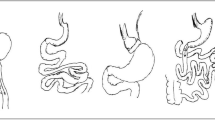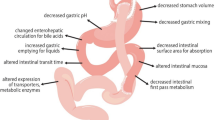Abstract
Purpose
Short bowel syndrome (SBS) patients require long-term parenteral nutrition following massive bowel resection, which causes intestinal failure-associated liver disease (IFALD). Previous reports have shown that glucagon-like peptide-2 (GLP-2) resulted in the bowel adaptation for SBS. The aim of this study was to evaluate the effect of GLP-2 for IFALD in a parenterally fed rat model.
Methods
Using rat, a catheter was placed in the jugular vein, and 90% small bowel resection (SBR) was performed. Animals were divided into three groups: SBR and total parenteral nutrition (TPN) (SBS/TPN group), SBR and TPN plus GLP-2 at 1 µg/kg/h [SBS/TPN/GLP-2 (low) group], and SBR and TPN plus GLP-2 at 10 µg/kg/h [SBS/TPN/GLP-2 (high) group]. On day 13, the liver was harvested and analyzed by using nonalcoholic fatty liver disease (NAFLD) score.
Results
Histologically, hepatic steatosis in the SBS/TPN group and SBS/TPN/GLP-2 (high) group was observed. Both steatosis and lobular inflammation score in the SBS/TPN/GLP-2 (low) group were significantly lower compared with those in the other two groups (p < 0.05). Active NAFLD score in the SBS/TPN/GLP-2 (low) group was significantly lower compared with that in the SBS/TPN/GLP-2 (high) group (p < 0.01).
Conclusion
Low-dose GLP-2 intravenous administration improves hepatic steatosis of IFALD following in an SBS parenterally fed rat model.



Similar content being viewed by others
References
Coletta R, Khalil BA, Morabito A (2014) Short bowel syndrome in children: surgical and medical perspectives. Semin Pediatr Surg 23:291–297. https://doi.org/10.1053/j.sempedsurg.2014.09.010
Kelly DA (2006) Intestinal failure-associated liver disease: what do we know today? Gastroenterology 130(2 Suppl 1):S70–S77. https://doi.org/10.1053/j.gastro.2005.10.066
Kakino S, Ohki T, Nakayama H, Yuan X, Otabe S, Hashinaga T, Wada N, Kurita Y, Tanaka K, Hara K, Soejima E, Tajiri Y, Yamada K (2018) Pivotal role of TNF-alpha in the development and progression of nonalcoholic fatty liver disease in a murine model. Horm Metab Res 50:80–87. https://doi.org/10.1055/s-0043-118666
Onishi S, Kaji T, Yamada W, Nakame K, Moriguchi T, Sugita K, Yamada K, Kawano T, Mukai M, Souda M, Yamada S, Yoshioka T, Tanimoto A, Ieiri S (2016) The administration of ghrelin improved hepatocellular injury following parenteral feeding in a rat model of short bowel syndrome. Pediatr Surg Int 32(12):1165–1171. https://doi.org/10.1007/s00383-016-3975-1
Machigashira S, Kaji T, Onishi S, Yamada W, Yano K, Yamada K, Masuya R, Kawano T, Nakame K, Mukai M, Ieiri S (2018) The protective effect of fish oil lipid emulsions on intestinal failure-associated liver disease in a rat model of short-bowel syndrome. Pediatr Surg Int 34(2):203–209. https://doi.org/10.1007/s00383-017-4190-4
Sigalet DL (2001) ALX-0600 (NPS Allelix Corp). Curr Opin Investig Drugs 2(4):505–509
Kaji T, Tanaka H, Holst J, Redstone H, Wallace L, de Heuval E, Sigalet DL (2008) The effects of variations in dose and method of administration on glucagon like peptide-2 activity in the rat. Eur J Pharmacol 596(1–3):138–145. https://doi.org/10.1016/j.ejphar.2008.07.070
Lim DW, Wales PW, Josephson JK, Nation PN, Wizzard PR, Sergi CM, Field CJ, Sigalet DL, Turner JM (2016) Glucagon-like peptide 2 improves cholestasis in parenteral nutrition-associated liver disease. J Parenter Enteral Nutr 40(1):14–21. https://doi.org/10.1177/0148607114551968
Nabeshima A, Yamada S, Guo X, Tanimoto A, Wang KY, Shimajiri S, Kimura S, Tasaki T, Noguchi H, Kitada S, Watanabe T, Fujii J, Kohno K, Sasaguri Y (2013) Peroxiredoxin 4 protects against nonalcoholic steatohepatitis and type 2 diabetes in a nongenetic mouse model. Antioxid Redox Signal 19(17):1983–1998. https://doi.org/10.1089/ars.2012.4946
Nakame K, Kaji T, Mukai M, Shinyama S, Matsufuji H (2016) The protective and anti-inflammatory effects of glucagon-like peptide-2 in an experimental rat model of necrotizing enterocolitis. Peptides 75:1–7. https://doi.org/10.1016/j.peptides.2015.07.025
Sigalet DL, Wallace LE, Holst JJ, Martin GR, Kaji T, Tanaka H, Sharkey KA (2007) Enteric neural pathways mediate the anti-inflammatory actions of glucagon-like peptide 2. Am J Physiol Gastrointest Liver Physiol 293(1):G211–G221. https://doi.org/10.1152/ajpgi.00530.2006
El-Jamal N, Erdual E, Neunlist M, Koriche D, Dubuquoy C, Maggiotto F, Chevalier J, Berrebi D, Dubuquoy L, Boulanger E, Cortot A, Desreumaux P (2014) Glugacon-like peptide-2: broad receptor expression, limited therapeutic effect on intestinal inflammation and novel role in liver regeneration. Am J Physiol Gastrointest Liver Physiol 307(3):G274–G285. https://doi.org/10.1152/ajpgi.00389.2012
Shi X, Zhou F, Li X, Chang B, Li D, Wang Y, Tong Q, Xu Y, Fukuda M, Zhao JJ, Li D, Burrin DG, Chan L, Guan X (2013) Central GLP-2 enhances hepatic insulin sensitivity via activating PI3K signaling in POMC neurons. Cell Metab 18(1):86–98. https://doi.org/10.1016/j.cmet.2013.06.014
Taher J, Baker C, Alvares D, Ijaz L, Hussain M, Adeli K (2018) GLP-2 dysregulates hepatic lipoprotein metabolism, inducing fatty liver and VLDL overproduction in male hamsters and mice. Endocrinology 159(9):3340–3350. https://doi.org/10.1210/en.2018-00416
Schoeler M, Klag T, Wendler J, Bernhard S, Adolph M, Kirschniak A, Goetz M, Malek N, Wehkamp J (2018) GLP-2 analog teduglutide significantly reduces need for parenteral nutrition and stool frequency in a real-life setting. Therap Adv Gastroenterol 11:1–11. https://doi.org/10.1177/1756284818793343
Acknowledgements
We thank Mr. Brain Quinn for his comments and help with the manuscript. This study was supported by a Grant-in-Aid for Scientific Research from the Japan Society for the Promotion of Science (JSPS: 19K10485, 19K09150, 19K09078, 19K03084, 19K18061, 19K17304, 19K18032, 18K08578, 18K16262 17K10555, 17K11514, 17K10183, 17K11515, 16K10466, 16K10094, 16K10095, 16K10434, 16H07090) and Grant for the experimental research in the Japanese Society for Parenteral and Enteral Nutrition.
Author information
Authors and Affiliations
Corresponding author
Ethics declarations
Conflict of interest
The authors declare no conflicts of interest in association with the present study.
Additional information
Publisher's Note
Springer Nature remains neutral with regard to jurisdictional claims in published maps and institutional affiliations.
Rights and permissions
About this article
Cite this article
Yano, K., Kaji, T., Onishi, S. et al. Novel effect of glucagon-like peptide-2 for hepatocellular injury in a parenterally fed rat model of short bowel syndrome. Pediatr Surg Int 35, 1345–1351 (2019). https://doi.org/10.1007/s00383-019-04560-8
Accepted:
Published:
Issue Date:
DOI: https://doi.org/10.1007/s00383-019-04560-8




